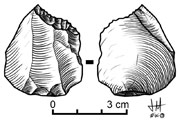Mesolithic 8000 - 4000 BC
The Mesolithic records of Wiltshire and Dorset are relatively rich with a mixture of minor artefact find spots and a small number of significant assemblages.

The drawing is of a typical Mesolithic stone tool. (Attribution Jose-Manuel Benito Alvarez licensed for reuse under a Creative Commons license.)
Cranborne Chase has long seen intensive investigation most recently by Martin Green. His finds demonstrate that there was a substantial presence in the landscape throughout the Mesolithic. There is a strikingly consistent distribution concentrated on patches of clay-with-flints in the north of the Chase with other sites in the Reading Beds and round the headwaters of the river Allen further south. Finds of Mesolithic Microliths in the Fir Tree Shaft, Down Farm suggest that the Mesolithic traditions within this area continued into the end of the fifth millennium BC and the transition to Neolithic practices was fairly rapid.
Environmental Evidence - It appears that the percentage of scrub and hazel woodland here remained higher than elsewhere in southern England. Mollusc data recovered from an intrusive Mesolithic deposit within the Neolithic Dorset Cursus provides a rare glimpse of a Mesolithic Chalkland environment of deciduous woodland with some large clearings.
This document forms part of the wider AONB Historic Environment Action Plans.
